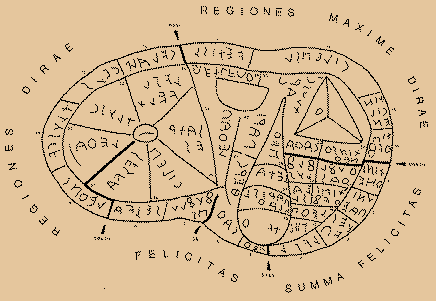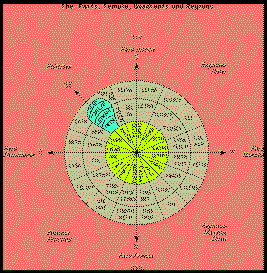History
"Haruspicy" is a method of divination that was practiced by the ancient Etruscans, who had an advanced civilization in Italy before the Roman Empire. In fact the Romans learned much of their culture and art from the Etruscans (or Rasna as they called themselves). They also brought the art of writing to Europe: the Latin alphabet is mostly derived from the Etruscan, and Runes are based on a northern Etruscan alphabet. Although the Etruscans have been called The People of the Book, very little of their writing survives. Their language is mysterious, being non-Indo-European and apparently unrelated to all other languages in the area; it has been only partly deciphered, and that quite recently.The principles of haruspicy were contained in the Libri Tagetici, a collection of books dictated by Tages, who was said to be a childlike being unearthed in a field by Tarchon, a Tarquinian peasant. After teaching the art of haruspicy to the Lucumones (high priests) of the twelve Etruscan tribes, Tages disappeared as suddenly as he had appeared.
"Haruspices" (diviners) from Etruria were consulted
privately throughout the history of the Roman Empire. The
Roman Senate also held haruspicy in the highest regard and
consulted haruspices before all important state decisions. The
emperor Claudius was a student of Etruscan language and
learning, and created a "college" of 60 haruspices that existed
until the beginning of the fifth century AD. In 408 they offered
their services to Pompeianus, the Prefect of Rome, to save the
city from the Goths; Innocent, the Christian bishop, reluctantly
agreed, so long as the rites were kept secret. It is likely that
in the end the rites were not performed; in any case Rome fell.
The open practice of "The Etruscan Discipline" continued into
the sixth century, but disappeared after that.
Ancient and Modern Practice
 In ancient times the haruspex (diviner) interpreted the divine
will by inspecting the entrails of a sacrificial animal. First
the animal was ritually slaughtered. Next it was butchered,
with the haruspex examining the size, shape, color, markings
etc. of certain internal organs, usually the liver (hepatoscopy),
but also the gall, heart and lungs. (One bronze "instructional
liver"
(the Piacenzi liver)
has survived from Etruria, but there
are also a Hittite (Boghazkeui) and a Babylonian version.)
Finally, when the animal had been butchered, the meat was
roasted and all the celebrants shared a sacred meal.
In ancient times the haruspex (diviner) interpreted the divine
will by inspecting the entrails of a sacrificial animal. First
the animal was ritually slaughtered. Next it was butchered,
with the haruspex examining the size, shape, color, markings
etc. of certain internal organs, usually the liver (hepatoscopy),
but also the gall, heart and lungs. (One bronze "instructional
liver"
(the Piacenzi liver)
has survived from Etruria, but there
are also a Hittite (Boghazkeui) and a Babylonian version.)
Finally, when the animal had been butchered, the meat was
roasted and all the celebrants shared a sacred meal.
Nowadays, few of us slaughter our own livestock; it is done in a factory where we don't have to see it. Also, entrails are offensive to modern sensibilities and most of us would prefer not to examine them. Fortunately there is a form of haruspicy, called "ooscopy", that is quite compatible with the modern world. Ooscopy substitutes an egg for the sacrificial animal and inspection of the opened egg for examination of the entrails. This works just as well as the ancient procedure, and perhaps better. Ancient haruspices didn't use it because you can't make a great public celebration out of the cracking of an egg. Ooscopic divination is described in the following.
Procedure
Preparation
i. In order that Haruspicy be effective, the Haruspex must be mentally prepared and have the proper attitude of Respect for the Gods. He [or she] must be Sober. He must have bathed and wear clean, festive clothes. [Special robes are not necessary; any clean, neat clothes will do. On the other hand, a special robe helps delimit the sacred from the profane. In ancient times a Haruspex wore a fringed mantle and a tall, conical hat with slightly concave sides. This is perhaps the origin of the stereotypical sorcerer's costume.]ii. The Haruspex should fast for at least twelve hours before the Rite; three days is best. During this time the Haruspex may meditate on the Question that is the object of the Divination.
iii. The Egg must be pure white and unblemished; it should be cleaned of all defilement. Otherwise the Haruspex has created a Vitium [defect in the ritual]. [It is not necessary to use a fertile egg.]
iv. A Patera [plain, white saucer], a Vessel of Water and a candle or other Flame should be brought.
v. Music, especially Flute music, may accompany the Ritual.
Part I
The Sacrifice
i. Say "TULAR EISNA SATH!" [Make the Divine Boundaries!] and carry the Egg and the Water in a Circle around the Altar, thus delimiting the Sacred from the Profane. Say "TA SACNI!" [This is the Sanctuary!]
ii. Say "AC EISI NERICN VACL!" [Offer the Water as a Libation for the Gods!] and pour out some of the Water to wash the Celebrants' hands.
iii. The Haruspex faces South, stretches out his hands, and in a loud voice implores the Gods to give Omen, with an invocation such as this:
"APLU! Phoebos! Apollo! Delian! Pythian! Lord of Delphi! Guardian of the Sibyls! Or by whatever other name You wish to be called, I pray and beseech You that You may by Your majesty be propitious and well-disposed to me, for which I offer this Egg. If I have worshiped You and still do worship You, You who taught Mankind the Art of Prophecy, You who have inspired my Divination, then come now and show Your Signs that I might know the Will of the Gods! I seek to know (say the Question) THUI SRENAR TEV! [Show Signs, here, now!]."
[APLU is the Etruscan name of the god of prophecy; you may of course call him by other names, Apollo, Hobal, Shamash, Horus, Mont (Menthu), etc.]
iv. The Assistant (if there be one) says, "FLERCHVA RATUM TUR!" ["Carry out the sacrifice according to the Law!"]
v. The Haruspex uncovers the Knife, with a single blow cracks the Egg, and then carefully opens and empties it onto the Patera. If the Yolk breaks, it is a Vitium and the Haruspex must begin again.
vi. The dedication is completed by all Celebrants saying: "IKAN NETSVIS ALPNU APLUS TURUCE." ["The Haruspex has given this as a gift to APLU."]
The Inspection
i. The Patera is turned so that the place where the Fibra Umbilicata [umbilical cord] leaves the Vitellus [yolk] and connects to the Embruon [embryo] is in the Southeast direction.ii. The shape of the Album [egg-white] should be definite and firm; if it runs then the Gods have refused to give clear Signs. Some Vitium may have been committed.
iii. The Album should divide naturally into two parts, the thicker Album Interius around the Vitellus, and the thinner Album Exterius around that. If these are not distinct, then the Signs cannot be clearly read.
iv. The Vitellus should be uniform and bright of Color and regular of Shape; not being so is an Ill Omen. The Sacrifice should be repeated.
v. Blood in the Vitellus is a Frightful Omen.
vi. The Album should be moderately clear, except for a Bubbles and Pale Features.
vii. The Egg is divided into Parts, Templa, Quadrants and Regions [see below], and the Haruspex must note carefully the Position and Character of every Mark, Bubble or other Feature, and their Number and Configuration. [A little practice will help distinguishing normal features of eggs from those that are significant.]
viii. If the Fibra crosses the Vitellus, it indicates a connection of the Regions crossed.
ix. The Haruspex should also note if any Region is excessively large, or diminished in size or absent.
x. A Monstrum [disfigurement] in a Part, Quadrant or Region is an especially Significant Sign and an Evil Omen.
The Parts
 Look at the chart.
Look at the chart.
 Send comments about this page
Send comments about this page